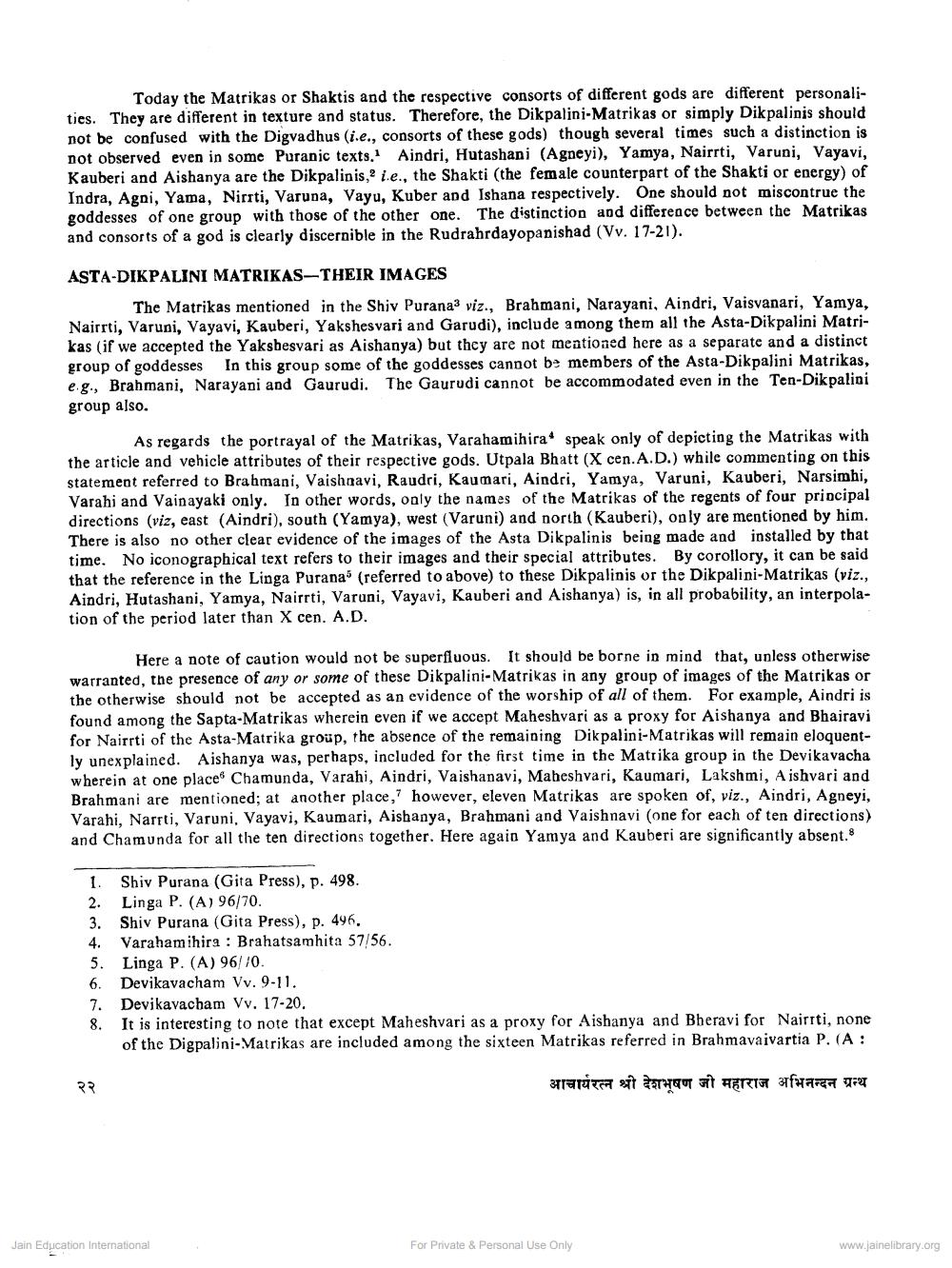________________
Today the Matrikas or Shaktis and the respective consorts of different gods are different personalities. They are different in texture and status. Therefore, the Dikpalini-Matrikas or simply Dik palinis should not be confused with the Digvadhus (i.e., consorts of these gods) though several times such a distinction is not observed even in some Puranic texts. Aindri, Hutashani (Agneyi), Yamya, Nairrti, Varuni, Vayavi, Kauberi and Aishanya are the Dikpalinis, i.e., the Shakti (the female counterpart of the Shakti or energy) of Indra, Agni, Yama, Nirrti, Varuna, Vayu, Kuber and Ishana respectively. One should not miscontrue the goddesses of one group with those of the other one. The distinction and difference between the Matrikas and consorts of a god is clearly discernible in the Rudrahrdayopanishad (Vy. 17-21).
ASTA-DIKPALINI MATRIKAS-THEIR IMAGES
The Matrikas mentioned in the Shiv Purana3 viz., Brahmani, Narayani, Aindri, Vaisvanari, Yamya, Nairrti, Varuni, Vayavi, Kauberi, Yakshesvari and Garudi), include among them all the Asta-Dik palini Matrikas (if we accepted the Yaksbesvari as Aishanya) but they are not mentioned here as a separate and a distinct group of goddesses in this group some of the goddesses cannot be members of the Asta-Dikpalini Matrikas, eg., Brahmani, Narayani and Gaurudi. The Gaurudi cannot be accommodated even in the Ten-Dik palini group also.
As regards the portrayal of the Matrikas, Varahamihirao speak only of depicting the Matrikas with the article and vehicle attributes of their respective gods. Utpala Bhatt (X cen.A.D.) while commenting on this statement referred to Brahmani, Vaishnavi, Raudri, Kaumari, Aindri, Yamya, Varuni, Kauberi, Narsimhi, Varahi and Vainayaki only. In other words, only the names of the Matrikas of the regents of four principal directions (viz, east (Aindri), south (Yamya), west (Varuni) and north (Kauberi), only are mentioned by him. There is also no other clear evidence of the images of the Asta Dikpalinis being made and installed by that time. No iconographical text refers to their images and their special attributes. By corollory, it can be said that the reference in the Linga Purana (referred to above) to these Dikpalinis or the Dikpalini-Matrikas (viz., Aindri, Hutashani, Yamya, Nairrti, Varuni, Vayavi, Kauberi and Aishanya) is, in all probability, an interpolation of the period later than X cen. A.D.
Here a note of caution would not be superfluous. It should be borne in mind that, unless otherwise warranted, the presence of any or some of these Dikpalini-Matrikas in any group of images of the Matrikas or the otherwise should not be accepted as an evidence of the worship of all of them. For example, Aindri is found among the Sapta-Matrikas wherein even if we accept Maheshvari as a proxy for Aishanya and Bhairavi for Nairrti of the Asta-Matrika group, the absence of the remaining Dikpalini-Matrikas will remain eloquently unexplained. Aishanya was, perhaps, included for the first time in the Matrika group in the Devikavacha wherein at one place Chamunda, Varahi, Aindri, Vaishanavi, Maheshvari, Kaumari, Lakshmi, Aishvari and Brahmani are mentioned; at another place, however, eleven Matrikas are spoken of, viz., Aindri, Agneyi, Varahi, Narrti, Varuni, Vayavi, Kaumari, Aishanya, Brahmani and Vaishnavi (one for each of ten directions) and Chamunda for all the ten directions together. Here again Yamya and Kauberi are significantly absent.
1. Shiv Purana (Gita Press), p. 498. 2. Linga P. (A) 96/70. 3. Shiv Purana (Gita Press), p. 496. 4. Varahamihira : Brahatsamhita 57/56. 5. Linga P. (A) 960. 6. Devikavacham Vv. 9.11. 7. Devikavacham Vv. 17-20. 8. It is interesting to note that except Maheshvari as a proxy for Aishanya and Bheravi for Nairtti, none
of the Digpalini-Matrikas are included among the sixteen Matrikas referred in Brahmavaivartia P. (A:
आचार्यरत्न श्री देशभूषण जी महाराज अभिनन्दन ग्रन्थ
Jain Education International
For Private & Personal Use Only
www.jainelibrary.org




